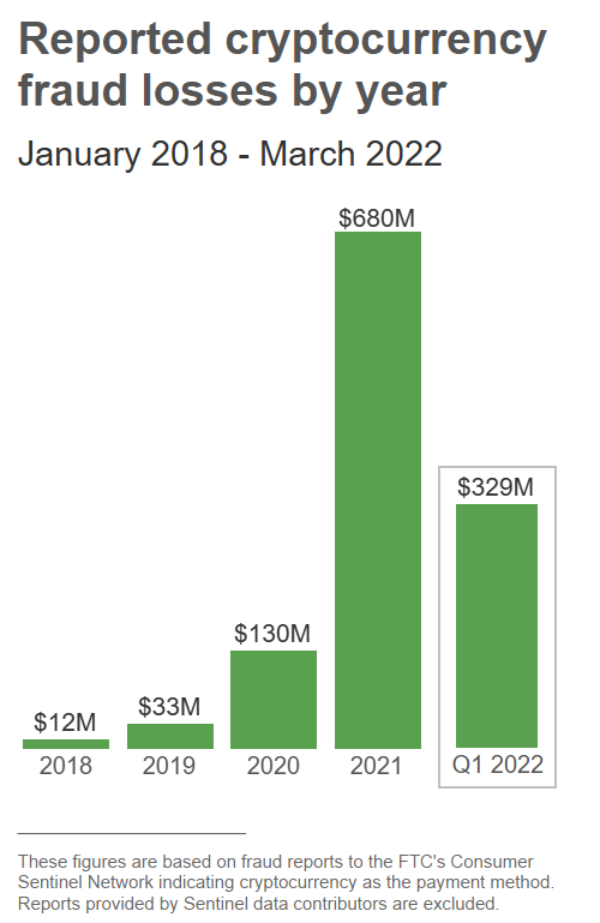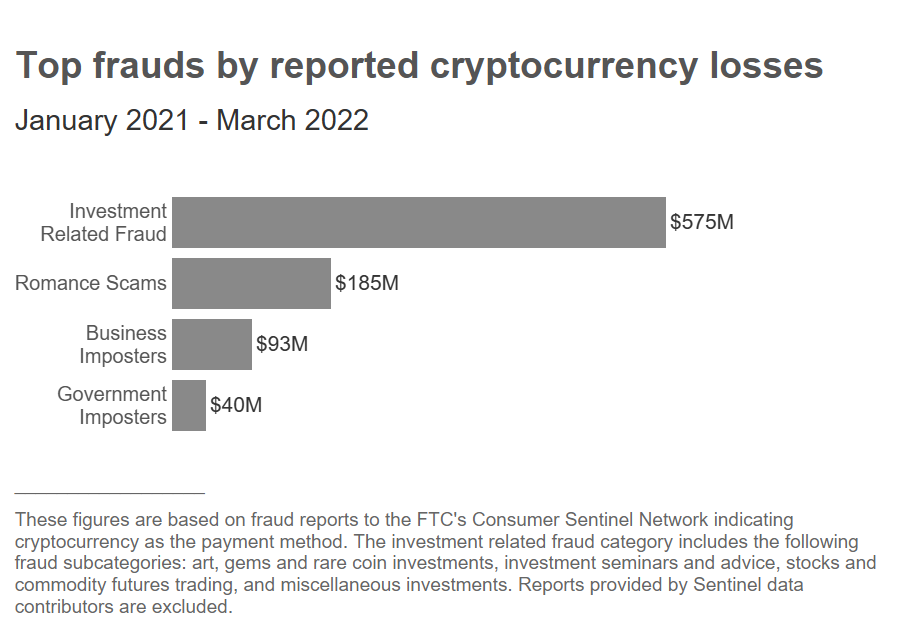Nearly half of the consumers that reported a cryptocurrency-related scam in 2021 said it started with an ad, post, or message on social media.
The Federal Trade Commission has labeled social media and crypto a “combustible combination for fraud,” with nearly half of all crypto-related scams originating from social media platforms in 2021.
Published on June 3, the report found that as much as $1 billion in crypto have been lost to scammers throughout the year, which was more than a five-fold increase from 2020, and nearly sixty times up from 2018.
New analysis finds consumers reported losing more than $1 billion in #cryptocurrency to scams since 2021. Most of the losses consumers reported were to bogus cryptocurrency investment scams: https://t.co/MYGTcaw1aS #DataSpotlight /1
— FTC (@FTC) June 3, 2022
As of March 31, 2022, the amount of crypto lost was already approaching half of the 2021 figure, showing that momentum doesn’t appear to be slowing.
The FTC found that Instagram (32%), Facebook (26%), Whatsapp (9%), and Telegram (7%) were the top platforms used for crypto scams.
Interestingly, Twitter, the social media platform widely adopted by the crypto-community, was not mentioned despite being littered with spam and scam bots touting fake crypto-giveaways.
Based on fraud reports to FTC’s Consumer Sentinel Network, the most common type of crypto scam was Investment Related Fraud, making up $575 million of the total $1 billion figure.
These scams often falsely promise potential investors that they can earn huge returns by investing in their cryptocurrency schemes, but people report losing all the money they ‘invest.'
According to the FTC, common investment scams include cases in which a so-called “investment manager” contacts a consumer, promising to grow their money - but only if the consumer buys cryptocurrency and transfers it into their online account.
Other methods include impersonating a celebrity who can multiply any cryptocurrency that a consumer sends them or promises of free cash or cryptocurrency.
The FTC also lists scams that involve investment in fake art, gems and rare coins, bogus investment seminars and advice, and other miscellaneous investment scams as part of this group.
The next largest crypto-scam-related losses came from Romance Scams at $185 million, in which a love interest tries to entice someone into investing into a crypto scam.
Business and Government Impersonation Scams came in third at a total of $133 million, in which scammers will target consumers claiming that their money is at risk due to fraud or a government investigation.
These scams can start with a text about a supposedly unauthorized Amazon purchase, or an alarming online pop-up made to look like a security alert from Microsoft. From there, people are reportedly told the fraud is extensive and their money is at risk.
The scammers will then pretend to be a representative of the bank to secure the person’s crypto.
In other cases, scammers have impersonated border patrol agents reportedly telling people their fiat accounts are frozen as part of a drug trafficking investigation. These scammers tell people the only way to protect their money is to put it in crypto. They’re directed to take out cash and feed it into a crypto ATM and are tricked into sending it to the scammers’ wallet address instead.
The report found that people aged 20 to 49 were most likely to lose crypto to a scammer, with those in their 30s the hardest hit, making up 35% of total reported fraud losses.
The amount of crypto lost rises up according to age group, with the median individual reported cryptocurrency losses for those in their 70s reaching up to $11,708, compared to just $1,000 for 18-19-year-olds.
An article on the FTC’s Consumer Advice website details a number of ways to avoid cryptocurrency scams:
- Only scammers demand payment in cryptocurrency. No legitimate business is going to demand you send cryptocurrency in advance – not to buy something, and not to protect your money. That’s always a scam.
- Only scammers will guarantee profits or big returns. Don’t trust people who promise you can quickly and easily make money in the crypto markets.
- Never mix online dating and investment advice. If you meet someone on a dating site or app, and they want to show you how to invest in crypto, or ask you to send them crypto, that’s a scam.
Information on these pages contains forward-looking statements that involve risks and uncertainties. Markets and instruments profiled on this page are for informational purposes only and should not in any way come across as a recommendation to buy or sell in these assets. You should do your own thorough research before making any investment decisions. FXStreet does not in any way guarantee that this information is free from mistakes, errors, or material misstatements. It also does not guarantee that this information is of a timely nature. Investing in Open Markets involves a great deal of risk, including the loss of all or a portion of your investment, as well as emotional distress. All risks, losses and costs associated with investing, including total loss of principal, are your responsibility. The views and opinions expressed in this article are those of the authors and do not necessarily reflect the official policy or position of FXStreet nor its advertisers.
Recommended Content
Editors’ Picks

Bitcoin reaches new highs near $90,000, on-chain data show chances of pullback
Bitcoin hit a new all-time high of $89,900 on Tuesday before easing to around $86,000, following a 30% surge since November 5. Technical indicators suggest the rally may be overstretched, with a potential corrective pullback ahead.

GIGA investor loses $6M to phishing scam via fake Zoom link
On Monday, a Gigachad (GIGA) investor lost $6.09 million due to a phishing attack involving a fake Zoom link. Crypto investigation firm Scam Sniffer declared the scam that led the victim to a malicious site, compromising their wallet.

Tron, Avalanche and Uniswap: Double-digit gains on the cards, technical indicators show
Tron is breaking above an ascending triangle formation on Tuesday, signaling a potential rally continuation. While AVAX and UNI are retesting their crucial support level — if supported, this suggests an upside move — all three altcoins look poised for double-digit gains as the crypto rally continues.

BNB: Bullish technical pattern validated, eyes all-time high
Binance Coin trades slightly down on Tuesday after breaking above an ascending triangle formation on the weekly chart, following a 12.5% rally last week. The technical outlook suggests a bullish breakout pattern and continuation of the rally, with a target set for a new all-time high of $825.

Bitcoin: Further upside likely after hitting new all-time high
Bitcoin hit a fresh high of $76,849 on Thursday as crypto-friendly candidate Donald Trump won the US presidential election. Institutional demand returned with the highest single-day inflow on Thursday since the ETFs’ launch in January.

Best Forex Brokers with Low Spreads
VERIFIED Low spreads are crucial for reducing trading costs. Explore top Forex brokers offering competitive spreads and high leverage. Compare options for EUR/USD, GBP/USD, USD/JPY, and Gold.

